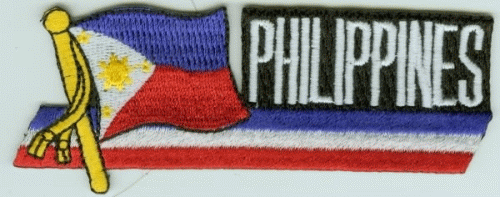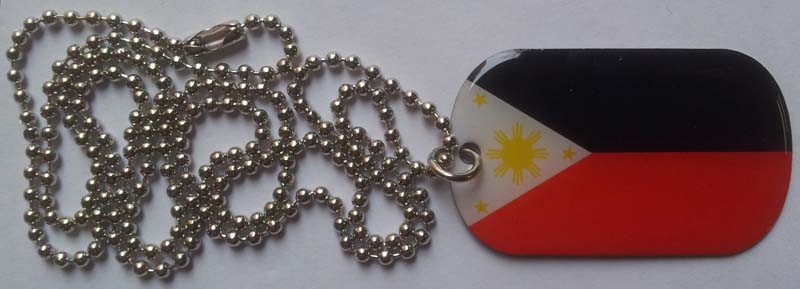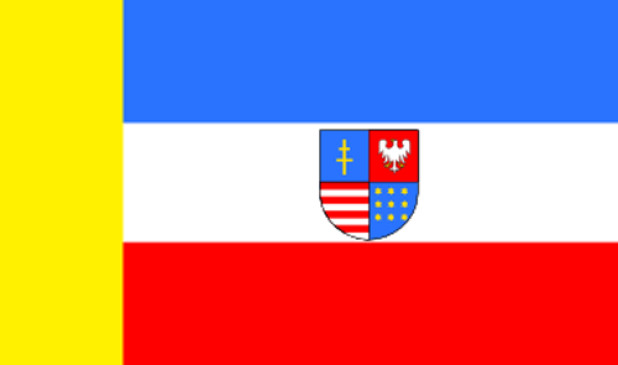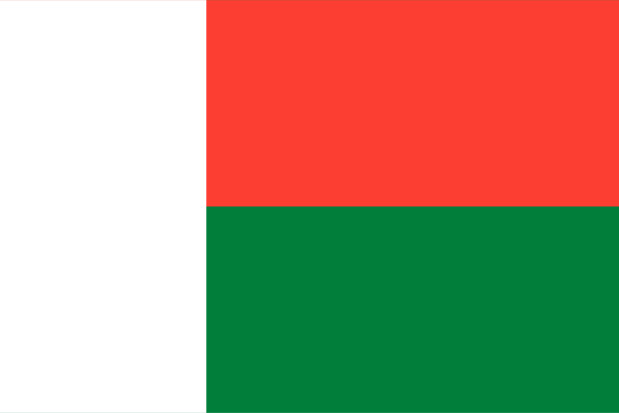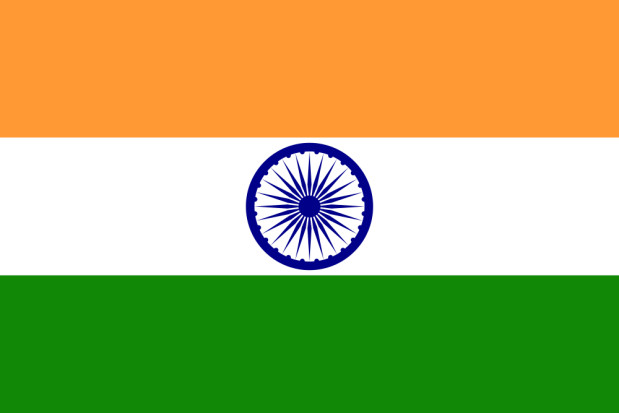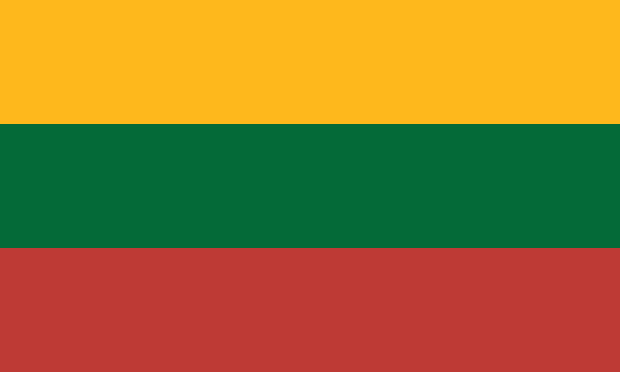Flagge von Philippinen
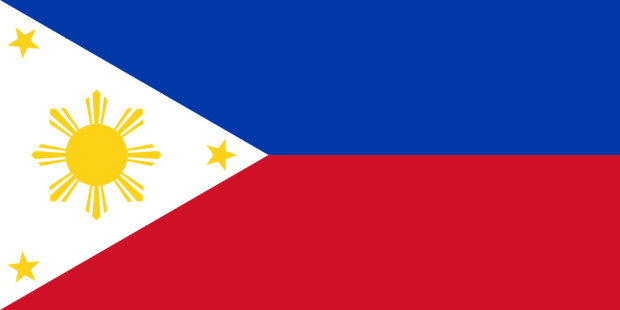
Hymne anhören
Topseller aus unserem Flaggen-Shop
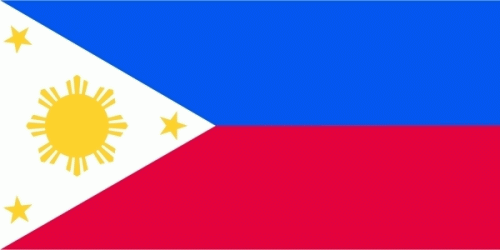
Philippinen Flagge 90x150 cm
9,90 €
Im Shop anzeigen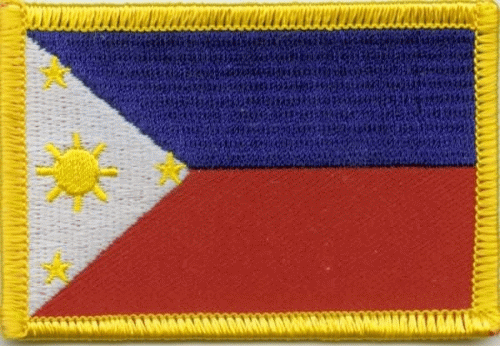
Philippinen Aufnäher / Patch
2,90 €
Im Shop anzeigenHintergrundwissen
The national flag of the Philippines on 12 Introduced in June 1898, but in the course of time is repeatedly changed in the shade. It was originally designed by Emilio Aguinaldo. The flag of the Philippines shall be flown at peace with the blue box to the top, while in times of war the red field on top.
Structure of the flag
The national flag consists of two horizontal stripes of equal width in the colors of royal blue and scarlet, which are covered by a white equilateral triangle at the leech. The center of the triangle holds a golden sun, which is surrounded by eight principal rays. Each beam consists of three individual rays again. At each corner of the triangle, also a five-pointed gold star is placed. Each star is designed so that one of the prongs on the top right corner shows where it is located.
The sides of the flag have a length to width ratio of 2:1. All three sides of the white triangle correspond in their dimensions each of the width of the flag.
Symbolism
According to official sources, the white triangle stands for equality and fraternity, the blue field for peace, truth and justice, and the red field for patriotism and valor. The eight-rayed sun stands for the freedom and the eight provinces in which erupted in 1896, the Philippine revolution against the Spanish colonial power, (Batangas, Bulacan, Cavite, Laguna, Manila, Nueva Ecija, Pampanga and Tarlac), and for this time martial law was declared. The three stars symbolize the main geographical areas of Luzon, Mindanao and the Visayas island group.
The symbolism of the flag was given in 1898 with the proclamation of Philippine Independence differs, however, from the current official interpretation. Then played the white triangle on the emblem of the Katipunan, the secret organization that rebelled in the underground against the Spanish rule. It is said that the colors of the flag were based. To the flag of the United States as an expression of gratitude for U.S. support in the fight against the Spaniards during the Philippine Revolution According to another interpretation is one of the three stars stand alone for the island of Panay and do not represent the entire Visayas.
Current Design
The current design of the Philippine national flag was designed by Emilio Aguinaldo, a general of the Philippine Revolution, when this in late 1897, in exile in Hong Kong. The first flag was sewn by Doña Marcela Marino de Agoncillo, which she made with the help of her daughter Lorenza and with the support of Doña Delfina Herbosa de Natividad, a niece of the Reformation leader Jose Rizal.
The flag was, however, only during the declaration of Philippine independence on 12 June 1898 in Kawit for the first time formally unfolds. According to an article in The Manila Times by Augusto de Viana, a respected historian of the National History Institute, can be found in historical textbooks and commemorative rites mentions showing that the flag on the 28th for the first time May was raised in 1898 at the Battle of Alapan, a district of Imus, Cavite. This is also cited in the Presidential Proclamation No. 374, on the 6th of President Diosdado Macapagal March was published 1965th The article goes on to say that the historical records indicate, the flag was first used in Cavite City, when General Aguinaldo unrolled during the first battles in the Spanish-American War.
Zwei gleich große horizontale Streifen (blau, rot); gleichseitiges weißes Dreieck an der Seite des Fahnenmastens; in dessen Zentrum befinden sich eine gelbe Sonne mit acht Strahlen, von denen jeder Strahl drei kleinere Strahlen aufweist, und drei kleinere gelbe fünfstrahlige Sterne in den Ecken des Dreiecks.
Bedeutung
Das weiße Dreieck symbolisiert Frieden und Reinheit. Die acht Strahlen der Sonne symbolisieren die acht Provinzen der Phillipinen, welche sich gegen die spanischen Kolonialherren aufbäumten. Die drei Sterne repräsentieren die drei Gebiete Luzon, Mindanao und Visayas. Das blaue Band symbolisiert den Patriotismus. Das rote Band der Flagge symbolisiert die Tapferkeit des Volkes. Im Kriegszustand des Landes wird das rote Band nach oben verschoben als Symbol der Tapferkeit und des Mutes.
Hymne
Das weiß ChatGPT zur Flagge von Philippinen
-
Die Nationalflagge der Philippinen, auch als "Lupang Hinirang" bekannt, symbolisiert die Unabhängigkeit des Landes. Sie besteht aus drei horizontalen Streifen in Blau, Rot und Gelb, die die Farben der alten philippinischen Flagge repräsentieren. Der weiße Stern in der Mitte steht für die Provinzen des Landes und die drei Sterne darunter symbolisieren die drei großen Inseln Luzon, Visayas und Mindanao.
-
Die philippinische Nationalflagge wurde 1898 während des Philippinischen Unabhängigkeitskrieges eingeführt. Sie besteht aus drei gleichmäßig geteilten Streifen in Blau, Rot und Gelb und einem weißen Dreieck mit einem achtstrahligen Stern in der Mitte. Der blaue Streifen symbolisiert Freiheit, der rote Streifen symbolisiert Mut und der gelbe Streifen symbolisiert Wohlstand. Der achtstrahlige Stern repräsentiert die acht Regionen der Philippinen.
-
Die Nationalflagge der Philippinen ist ein bunter Querstreifen aus drei gleich großen, waagerechten Streifen. Der obere Streifen ist blau, der mittlere weiß und der untere rot. In der Mitte der Flagge befindet sich ein achtstrahliger weißer Stern, umgeben von drei fünfzackigen goldenen Sternen. Der blaue Streifen steht für Freiheit, der weiße für Reinheit und der rote für Mut und Tapferkeit. Der weiße achtstrahlige Stern symbolisiert die acht Provinzen, die sich 1892 zur Revolution gegen die spanische Kolonialherrschaft vereinigten.
Entdecken Sie etwas Neues
Zufällige Flaggen aus unserer großen Flaggendatenbank. Lassen Sie sich überraschen.
